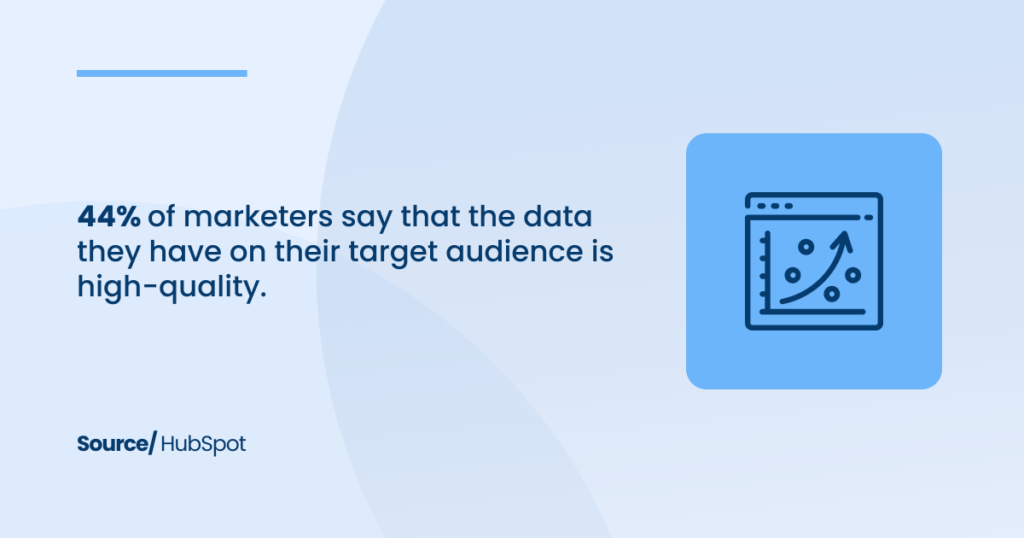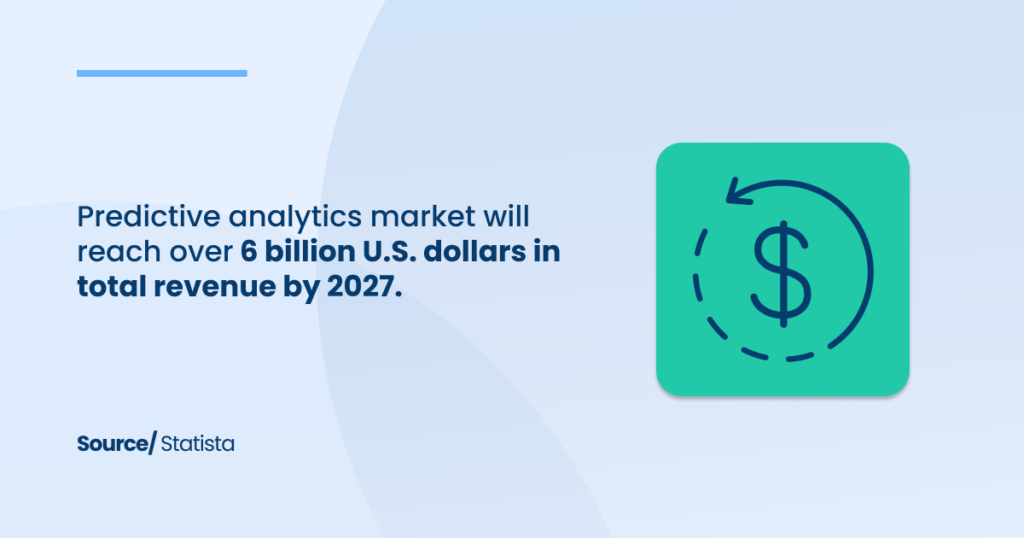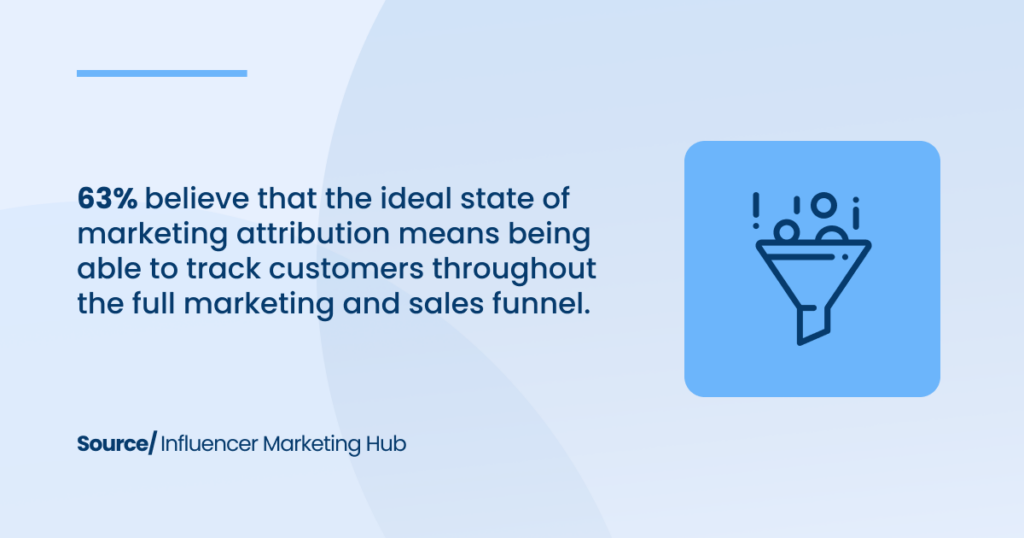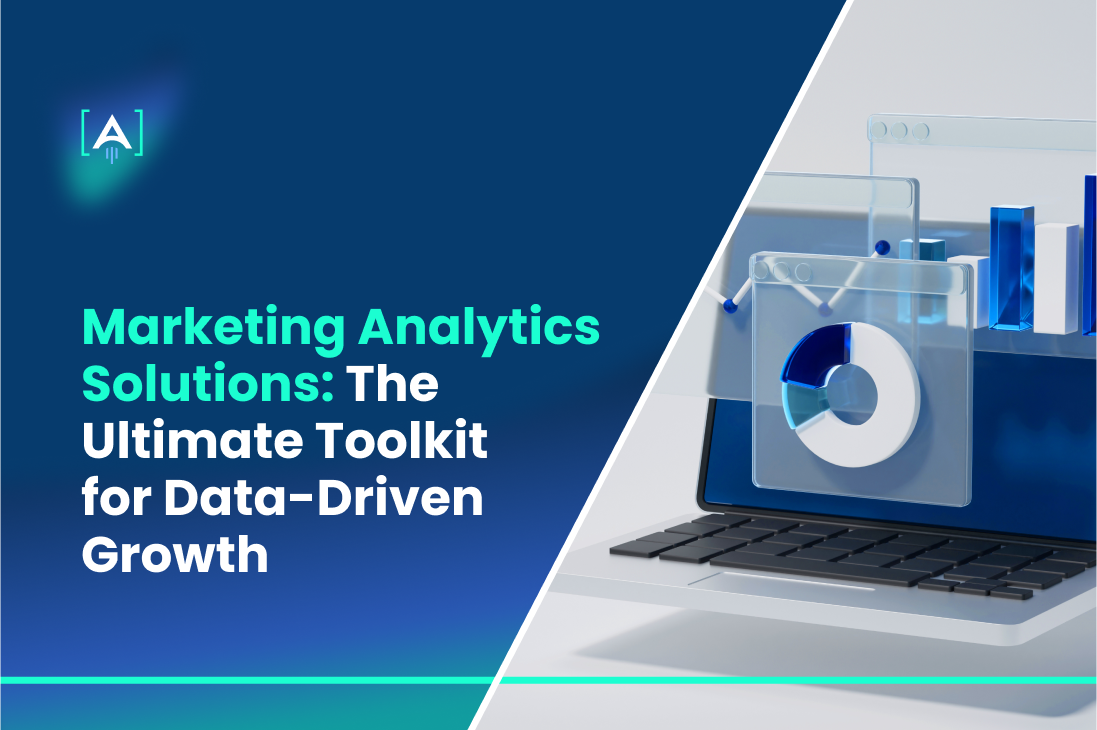Data has emerged as the most valuable asset.
To harness its potential, organizations are turning to marketing analytics solutions.
These powerful tools give businesses the insights to make data-driven decisions, optimize marketing strategies, and achieve sustainable growth.
The global big data market is forecasted to grow to 103 billion U.S. dollars by 2027, more than double its expected market size in 2018.
Source: Big data market size revenue forecast worldwide from 2011 to 2027, Statista
Statista notes that the majority of businesses said that investment in data and analytics was a top priority.
Highlighting the growing need for data analytics, a professional Marketing Analytics & Reporting Agency will help organizations make data-driven decisions and optimize their marketing strategies.
The blog post will cover marketing analytics solutions and comprehensive suite of tools and techniques to collect, analyze, and interpret marketing data.
Building a Data-Driven Marketing Strategy
Creating a successful data-driven marketing strategy is crucial for businesses looking to remain competitive in today’s market.
Source: State of data and analytics investment at companies worldwide in 2023, Statista
With the help of marketing analytics solutions, companies can collect, analyze, and apply data to improve their marketing efforts, making more informed decisions and driving greater ROI.
The Role of Data in Marketing
The role of data in marketing has evolved significantly with the advent of AI marketing analytics and advanced marketing analytics software.
Today, marketers no longer rely on intuition or outdated practices; instead, they use analytics tools to identify patterns, measure success, and optimize campaigns.
Collecting Customer Data
The foundation of any successful data-driven marketing strategy lies in the accurate and ethical collection of customer data.
With the right approach, marketers can use data to gain valuable insights into customer behavior, preferences, and engagement with marketing campaigns.
Sources of Customer Data: There are several ways to collect data for your marketing efforts. Online behaviors, social media interactions, website traffic, email engagement, and transaction history all provide valuable data points.
Using Google Analytics is one of the most effective ways to gather data, as it allows businesses to track website interactions, user journeys, and overall campaign performance.
Types of Data to Collect:
- Demographic Data: Information like age, gender, and location helps marketers target specific audience segments.
- Behavioral Data: Tracking user actions on a website, such as what pages they visit, how long they stay, and what they click on.
- Transactional Data: Purchase history and order frequency provide insights into customer loyalty and lifetime value.
Advanced marketing analytics tools and analytics software allow businesses to integrate these data types from multiple sources, helping marketers form a comprehensive view of their audience.
Challenges in Data Collection: As businesses collect more data, they must also ensure compliance with privacy regulations like GDPR and CCPA.
This is where partnering with a marketing analytics consulting agency can help, as they guide businesses in ethical data collection and utilization practices.
How to Leverage Data for Personalization
Once businesses have collected customer data, the next step is to leverage it effectively to create personalized experiences.

Personalization is key to improving engagement, driving conversions, and fostering loyalty. With AI marketing analytics and top marketing analytics tools, businesses can segment audiences and deliver targeted & relevant content.
- Segmentation: Data enables marketers to break down their audience into smaller, more specific groups based on behavior, demographics, or preferences. Once segmented, marketers can tailor their messages and offers, making them more appealing and relevant.
- Targeted Messaging: Personalization doesn’t stop at segmentation. Businesses can also use data to deliver personalized messages to individual customers.
Whether through personalized emails, website experiences, or product recommendations, leveraging data analytics in business allows for more precise targeting, which improves the effectiveness of marketing campaigns.
- Personalized Marketing Campaigns: With the right marketing analytics tools, businesses can create tailored marketing campaigns based on past customer behavior.
For instance, businesses can create automated email campaigns that trigger based on actions such as cart abandonment, product views, or purchase history.
These tailored messages drive higher engagement and conversion rates, as they are directly aligned with the customer’s needs and interests.
- AI and Automation for Personalization: AI marketing analytics plays a significant role in taking personalization to the next level. AI-powered tools can analyze large datasets in real time, helping businesses create predictive models and recommend personalized content or product suggestions.
By using machine learning algorithms, AI tools continuously refine these models, ensuring that the content becomes more relevant over time.
Tools for Marketing Analytics
To effectively build a data-driven marketing strategy, businesses must use the right marketing analytics tools. These tools help gather, process, and analyze data, turning raw information into actionable insights that drive decision-making.
Whether tracking marketing campaign metrics or automating customer segmentation, the right tools are critical to success.
Popular Tools (Google Analytics, HubSpot, etc.)
- Google Analytics: One of the most widely used tools, Google Analytics provides businesses with deep insights into their website traffic, user behavior, and overall campaign performance.
It tracks everything from page views and session durations to goal conversions, allowing marketers to optimize their digital strategies in real-time. The platform’s integration with Google Ads also makes it invaluable for measuring the ROI of advertising campaigns.
- HubSpot: As a marketing analytics software, HubSpot is perfect for businesses that need a comprehensive tool for inbound marketing.
It allows marketers to track leads, sales, and engagement across multiple channels while offering tools for content creation, email marketing, and customer management.
- Adobe Analytics: This is a more advanced marketing analytics solution that uses machine learning and AI to deliver predictive insights.
It provides detailed analytics on audience segmentation, customer journeys, and conversion funnels, making it a top choice for larger enterprises looking to scale their data-driven marketing efforts.
- Other Top Marketing Analytics Tools: Some other valuable options include:
- Salesforce Marketing Cloud: A robust CRM and analytics platform that tracks customer engagement and helps create personalized marketing journeys.
- Kissmetrics: Specializes in customer journey tracking and cohort analysis, giving businesses insights into customer behaviors over time.
- Mixpanel: Focuses on user behavior analytics, allowing businesses to track user interactions with their products and digital assets.
By using these top marketing analytics tools, businesses can easily measure and optimize their marketing campaigns, improving overall efficiency and growth.
Choosing the Right Tool for Your Business
Choosing the right marketing analytics tool for your business depends on your needs, size, and goals.
- Business Size and Complexity: Small businesses may benefit from tools like Google Analytics and HubSpot, which are easy to use and affordable. Larger enterprises with more complex needs might opt for solutions like Adobe Analytics or Salesforce, which offer more advanced capabilities, such as machine learning and cross-channel analysis.
- Integration with Existing Systems: When choosing a marketing analytics solution, consider how well the tool integrates with your existing systems. For example, a business using QuickBooks for accounting might prefer an analytics tool that easily syncs with their financial software to streamline data flow.
- Budget: Some tools, like Google Analytics, offer free versions, making them an excellent choice for smaller businesses or startups. Others, like Adobe Analytics, offer premium solutions with more advanced features, which are ideal for enterprises with a larger budget.
- Ease of Use: User-friendly tools like HubSpot are great for teams that don’t have dedicated data analysts. These platforms simplify data collection, analysis, and reporting, making it easier for marketers to use the insights to optimize their marketing campaigns.
- Advanced Features: If your business relies heavily on data-driven decisions, you might need tools with more advanced features like AI-driven analytics, multi-channel attribution, or real-time reporting. Solutions like Salesforce and Adobe Analytics offer these features, allowing for more precise and informed decision-making.
Advanced Marketing Analytics Techniques
As marketing becomes more data-driven, businesses are increasingly adopting advanced analytics techniques to gain deeper insights into their campaigns, improve decision-making, and drive growth.
Marketing analytics solutions now go beyond tracking simple metrics like impressions and clicks. Businesses leverage predictive analytics, attribution models, and a range of marketing data insights to optimize their strategies and maximize returns.
Predictive Analytics and Forecasting
Predictive analytics is one of the most powerful tools in a marketer’s toolkit. By using historical data and machine learning algorithms, businesses can forecast future trends, customer behaviors, and campaign outcomes.

Predictive analytics is not only about understanding what has already happened but also about anticipating what will happen next. This technique helps marketers make data-backed decisions that can enhance marketing performance and improve return on investment (ROI).
How Predictive Analytics Works
Predictive analytics works by analyzing past data to identify patterns and trends that can be used to predict future events. In the context of marketing, predictive analytics can help forecast customer behaviors, such as purchase intent, churn likelihood, or content preferences. Here’s how predictive analytics works in a marketing setting:
- Data Collection: The process starts with gathering data from multiple sources, including mobile marketing analytics, web marketing analytics, and social media marketing analytics platforms. This data includes customer behaviors, demographics, purchasing history, and interactions across multiple touchpoints.
- Data Analysis: Using marketing tools like Google Analytics, HubSpot, or advanced marketing software, the collected data is analyzed to identify key trends, behaviors, and correlations. The analysis might focus on determining factors that influence customer engagement, conversions, or campaign success.
- Model Development: Data scientists and marketers collaborate to build predictive models based on historical data. These models use advanced machine learning algorithms to detect patterns and make accurate predictions about future outcomes.
- Model Testing and Validation: Before deploying predictive models, marketers need to test and validate them to ensure they are reliable. This phase often involves applying the model to a subset of the data and comparing the predictions against actual results to refine the accuracy of the model.
- Implementation: Once the model is validated, it is deployed within marketing initiatives. For example, predictive models might be used to identify customers most likely to make a purchase, enabling marketers to target them with personalized campaigns.
Using Predictive Models for Campaign Optimization
Predictive models can be a game-changer for campaign optimization.
By analyzing marketing data insights from previous campaigns, marketers can forecast which strategies are most likely to succeed.
This allows businesses to make proactive adjustments to their campaigns, optimizing their budgets and efforts toward tactics that deliver the highest return.
- Audience Targeting: Predictive analytics helps businesses refine their audience segmentation. Marketers can use predictive models to identify which customers are more likely to engage with specific campaigns, products, or marketing analytics services. This results in more personalized and relevant communications, boosting engagement rates.
- Content Personalization: By forecasting which types of content will resonate most with different audience segments, marketers can tailor their messaging for each group. Predictive models can analyze the type of content that drove previous successes and use that data to create future strategies.
- Timing Optimization: Predictive models help marketers determine the best time to launch campaigns. Whether it’s email marketing, social media ads, or mobile push notifications, predictive analytics can optimize the timing for maximum engagement.
- Budget Allocation: By predicting which channels will deliver the best ROI, predictive models help marketers allocate their budgets more effectively. For instance, social media marketing analytics may reveal that Instagram drives more conversions than Facebook, allowing marketers to focus more on that platform.
- Influencer Marketing Analytics: Predictive models can also be used to optimize influencer marketing efforts. By analyzing past campaign data, businesses can forecast which influencers are most likely to generate high engagement and conversions, leading to better partnerships and more effective influencer campaigns.
Using predictive models allows businesses to streamline their marketing initiatives, increasing efficiency while reducing costs and improving overall results.
Attribution Models in Marketing
Attribution models are essential for understanding which marketing channels and touchpoints contribute most to a conversion.

Without attribution modeling, it is challenging for businesses to gauge the effectiveness of their marketing initiatives, resulting in an inefficient allocation of marketing resources.
With the rise of multichannel marketing, understanding how different channels work together is critical for maximizing marketing performance.
Multi-Touch Attribution
Multi-touch attribution assigns credit for a conversion across multiple marketing touchpoints rather than giving all the credit to the first or last interaction.
This model offers a more holistic view of how different channels, such as SEO, social media, email marketing, and paid advertising, work together to influence a customer’s decision-making journey.
- Comprehensive View of Customer Journeys: In today’s marketing landscape, customers interact with multiple touchpoints before making a purchase. They might click on an ad, read a blog post, sign up for an email newsletter, and finally make a purchase through a paid search ad.
With multi-touch attribution, businesses can track and evaluate how each of these touchpoints contributes to the final conversion.
- Channel Performance Evaluation: By utilizing web marketing analytics and SEO marketing analytics, marketers can see how each channel performs and contributes to the overall campaign.
Multi-touch attribution allows businesses to identify which combinations of channels are most effective and make adjustments as necessary to optimize performance.
- Better Budget Allocation: With multi-touch attribution, businesses can better understand the value of each marketing channel, enabling more precise budget allocation.
For instance, if a social media campaign consistently assists conversions but doesn’t drive direct conversions, multi-touch attribution will still highlight its importance in the customer journey, ensuring it receives the appropriate share of the budget.
By adopting multi-touch attribution, businesses gain a clearer picture of their marketing performance across different channels and can make more informed decisions about where to invest their resources.
Last-Click vs. First-Click Attribution
In contrast to multi-touch attribution, both last-click and first-click attribution models give full credit to a single touchpoint in the customer journey.
Understanding the differences between these models is crucial for marketers when analyzing campaign performance.
Last-Click Attribution: In last-click attribution, all the credit for a conversion goes to the last interaction a customer had before making a purchase.
This model is simple to implement and commonly used in marketing analytics tools like Google Analytics. However, last-click attribution tends to undervalue other touchpoints that contributed earlier in the customer journey, such as social media ads, blog posts, or emails.
- Advantages: Simple to understand and implement.
- Disadvantages: Fails to account for the overall customer journey and the influence of other channels on the final decision.
First-Click Attribution: In first-click attribution, all the credit goes to the first interaction a customer had with a brand, regardless of subsequent interactions.
For example, if a customer first discovered a brand through an organic search but later converted through a retargeting ad, the first-click model would give credit to the organic search.
- Advantages: Highlights the importance of brand awareness and top-of-the-funnel efforts.
- Disadvantages: Overlooks the influence of middle and bottom-of-the-funnel interactions that helped drive the conversion.
Which Model is Best?
Both last-click and first-click attribution have limitations in accurately reflecting the complexity of modern marketing funnels.
For businesses with multi-channel marketing strategies, multi-touch attribution or custom attribution models that weigh the importance of each touchpoint might provide a more accurate assessment of campaign performance.
Choosing the right attribution model depends on your business goals and marketing strategy.
Partner with [A] Growth Agency for Your Marketing Analytics & Reporting Tools and Techniques
Marketing Analytics & Reporting Tools are indispensable for businesses seeking to optimize their marketing strategies and achieve sustainable growth.
By leveraging these powerful tools, organizations can gain deeper insights into customer behavior and measure marketing performance.
[A] Growth Agency will stand next to you. We’re a Growth Agency where data-driven strategies meet creative experiments.
Remember that Excellence is our standard. We cultivate a team of ‘A players’ – top-tier talents who bring passion and expertise to every challenge.
Innovation drives us forward. We continuously push boundaries, blending cutting-edge marketing analytics solutions with bold creativity.
If that is what you are really in search of, go ahead!

